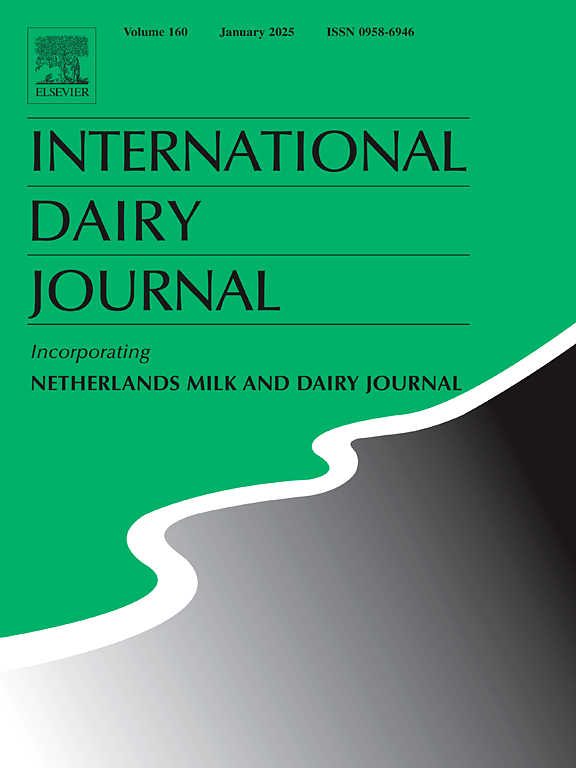Comparative analysis of high-protein and lactose-reduced semi-skim yogurt production at different scales: Effects on lactic fermentation metabolites, physicochemical, microbiological and physical properties, and sensory characteristics
IF 3.1
3区 农林科学
Q2 FOOD SCIENCE & TECHNOLOGY
引用次数: 0
Abstract
Protein increase in yogurt is a topic of current interest in the dairy industry, in order to obtain products with better nutritional and sensory characteristics. The development of prototypes at laboratory scale allows experimentation to achieve the desired characteristics, but it is necessary to adapt manufacturing conditions at larger scales to corroborate the feasibility of the process and the maintenance of the features proposed in the design. In this work, physicochemical aspects (pH, titratable acidity, and global composition), lactic fermentation metabolites (lactic acid and volatile compounds) and physical properties (whey holding capacity, rheology, texture and microstructure), of a high-protein and lactose-reduced semi-skim yogurt manufactured at laboratory scale (LS) and pilot scale (PS), were compared. Also, a sensory analysis was performed on PS yogurt. Yogurt formula comprised semi-skim milk, skim milk powder and whey protein concentrate 35 %. A commercial β-galactosidase was used for lactose hydrolysis and added along with the starter culture. Protein (∼6.3 g 100 g−1), lactose (1.4–1.8 g 100 g−1), and lactic acid (1.3–1.7 g 100 g−1) were similar for both LS and PS. The main differences in volatile compounds were detected for minority compound groups (aldehydes and esters). Some differences were found between LS and PS physical properties, attributed to differences in cooling/stirring conditions between manufacturing scales. A trained sensory panel detected high scores for yogurt's descriptors. The consumer sensory test revealed high acceptance and intention of purchasing of the product. Scaling up affected some yogurt parameters, and contributing factors were identified. Notably, the final product had improved nutritional properties and acceptable sensory qualities.
不同规模下高蛋白和乳糖还原半脱脂酸奶生产的比较分析:对乳酸发酵代谢物、理化、微生物和物理特性以及感官特性的影响
提高酸奶中的蛋白质含量是目前乳品行业关注的一个话题,以获得具有更好营养和感官特性的产品。在实验室规模上开发原型可以通过实验来实现所需的特性,但有必要在更大的规模上适应制造条件,以证实工艺的可行性和设计中提出的特征的维护。在这项工作中,比较了实验室规模(LS)和中试规模(PS)生产的高蛋白和乳糖还原半脱脂酸奶的物理化学方面(pH值、可滴定酸度和总体成分)、乳酸发酵代谢物(乳酸和挥发性化合物)和物理性质(乳清保持能力、流变学、质地和微观结构)。并对PS酸奶进行了感官分析。酸奶配方由半脱脂牛奶、脱脂奶粉和浓缩乳清蛋白35%组成。用商业β-半乳糖苷酶水解乳糖,并与发酵剂一起添加。LS和PS的蛋白质(~ 6.3 g 100 g−1)、乳糖(1.4-1.8 g 100 g−1)和乳酸(1.3-1.7 g 100 g−1)相似。挥发性化合物的主要差异是在少数化合物群(醛类和酯类)中检测到的。LS和PS之间的物理性能存在一些差异,这是由于不同的冷却/搅拌条件造成的。一个训练有素的感官小组检测到酸奶描述符的高分。消费者感官测试显示产品的接受度和购买意愿较高。放大会影响酸奶的一些参数,并确定了影响因素。值得注意的是,最终产品具有更好的营养特性和可接受的感官品质。
本文章由计算机程序翻译,如有差异,请以英文原文为准。
求助全文
约1分钟内获得全文
求助全文
来源期刊

International Dairy Journal
工程技术-食品科技
CiteScore
6.50
自引率
9.70%
发文量
200
审稿时长
49 days
期刊介绍:
The International Dairy Journal publishes significant advancements in dairy science and technology in the form of research articles and critical reviews that are of relevance to the broader international dairy community. Within this scope, research on the science and technology of milk and dairy products and the nutritional and health aspects of dairy foods are included; the journal pays particular attention to applied research and its interface with the dairy industry.
The journal''s coverage includes the following, where directly applicable to dairy science and technology:
• Chemistry and physico-chemical properties of milk constituents
• Microbiology, food safety, enzymology, biotechnology
• Processing and engineering
• Emulsion science, food structure, and texture
• Raw material quality and effect on relevant products
• Flavour and off-flavour development
• Technological functionality and applications of dairy ingredients
• Sensory and consumer sciences
• Nutrition and substantiation of human health implications of milk components or dairy products
International Dairy Journal does not publish papers related to milk production, animal health and other aspects of on-farm milk production unless there is a clear relationship to dairy technology, human health or final product quality.
 求助内容:
求助内容: 应助结果提醒方式:
应助结果提醒方式:


